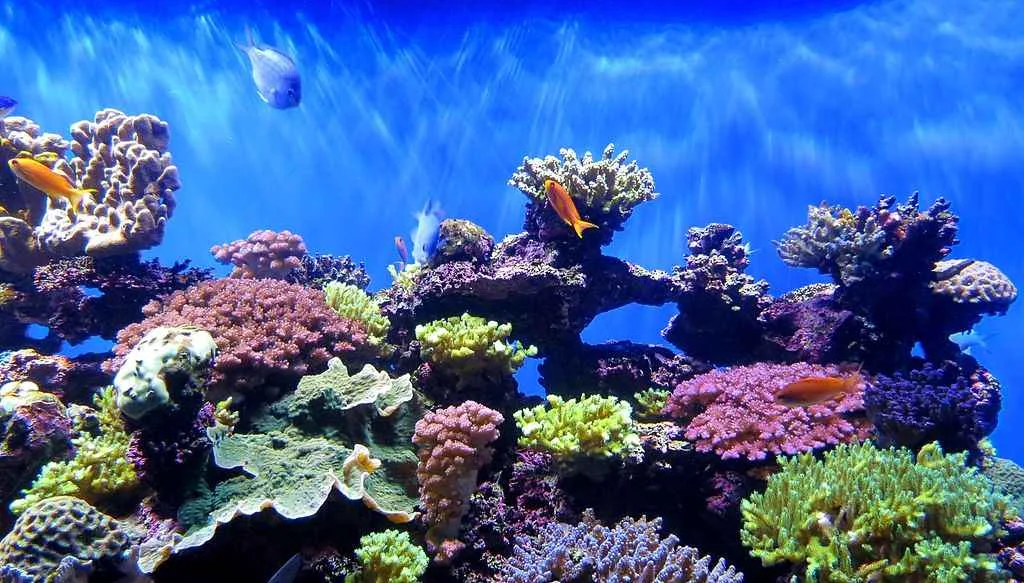The Great Barrier Reef is a mosaic of 2,900 individual reefs off the coast of Queensland in northeastern Australia. The sprawling reef can be seen from space and is not only the largest coral reef system in the world, but also the largest structure on Earth made by living organisms.
 |
| Great Barrier Reef |
Where is the Great Barrier Reef?
The Great Barrier Reef stretches over 2,575 kilometers, a little more than the distance between Boston and Miami. It covers an area of 344,400 square km, stretching from the Torres Strait at its northernmost point to Fraser Island in the south. The reef includes Lady Elliot Island and the smaller Murray Islands.
Animals of the Great Barrier Reef
A coral reef consists of coral polyps, which are animals in the jellyfish family, along with algae called zooxanthellae. In exchange for a cozy and safe place to live, algae provide the building blocks polyps need to survive and make limestone to build reef structures. As a result they have created huge underwater structures of incalculable beauty and value.
The Great Barrier Reef supports a wide variety of life forms. Thirty species of whales, dolphins, and porpoises have been recorded on the Great Barrier Reef, including Minke Fin whales, the Indo-Pacific humpback dolphin, and the humpback whale.
 |
| Great Barrier Reef |
Dugongs, large marine mammals that are related to manatees, live peacefully throughout the entire reef area.
More than 1,500 species of fish live on the reef, including clownfish, red bass, red-throated emperor, and several species of snapper and coral trout. About 5,000 species of mollusks live on the reef.
Seventeen species of sea snakes live in the Great Barrier Reef in warm waters up to 49 meters deep, these types of snakes are more common in the south than in the north.
Six species of sea turtles: the green turtle, the leatherback turtle, the hawksbill turtle, the loggerhead turtle, the smooth-shelled turtle and the olive ridley turtle, have the reef as a place to reproduce.
Saltwater crocodiles live in mangroves and salt marshes near the reef shoreline.
The Great Barrier Reef is home to 215 species of birds (including 22 species of seabirds and 32 species of shorebirds) that visit the reef or nest on the islands. The white-bellied sea eagle and tern are frequently seen across the reef.
The 15 species of seaweed found along the reef attract dugongs and turtles and provide habitats for fish. The most common types of seagrass are Halophila and Halodule.
Reefs are vital to the survival of several endangered species, so much so that in 2004, the Great Barrier Reef Marine Park Authority (GBRMPA) increased the number of highly protected areas by nearly 30 percent.
How the reef was formed
The Great Barrier Reef is roughly 500,000 years old, but it hasn't always been what it looks like today. The reefs on the Australian continental shelf have taken many forms over the years depending on the sea level, the current formation is between 6,000 and 8,000 years old.
 |
| Great Barrier Reef |
According to the Australian Institute of Marine Sciences and other scientific research, the current reef began to form during the Last Glacial Maximum. This period, which occurred about 26,500 years ago, between 19,000 and 20,000 years ago, marked the beginning of major environmental changes in the region, including a dramatic drop in sea levels.
The land that forms the base of the Great Barrier Reef is the rest of the sediments of the Great Dividing Range, the largest mountain range in Australia. About 13,000 years ago, the sea level was 61 meters lower than the current level, and corals began to grow around the hills of the coastal plain, which had become mainland islands.
Sea level continued to rise during a period of global warming as glaciers melted away. Most of the mainland islands submerged, and the coral remained to form the reefs and cays (low elevation sandy islands) of today.
Variety of reefs
The Great Barrier Reef designated World Heritage area is divided into 30 regions consisting of different types of reefs.
Crescentic reefs, shaped like a crescent, as the name implies, are the most common form of reef on the barrier reef. These types of reefs are found around Lizard Island, as well as north of the Great Barrier Reef Marine Park and in Swain Reefs.
Flat reefs known as flat reefs are found in the northern and southern parts, near the Cape York Peninsula, Princess Charlotte Bay, and Cairns.
The northern part of the Great Barrier Reef features ribbon reefs, which are narrow and meandering, and delta reefs that, as the name implies, resemble river deltas.
Marginal reefs, which join the mainland, are rare. Most are in the southern part of the Great Barrier Reef and are linked to higher islands such as the Whitsunday Islands.
Patch reefs are found in the south of the Great Barrier Reef, and further north, off the coast of Princess Charlotte Bay.
